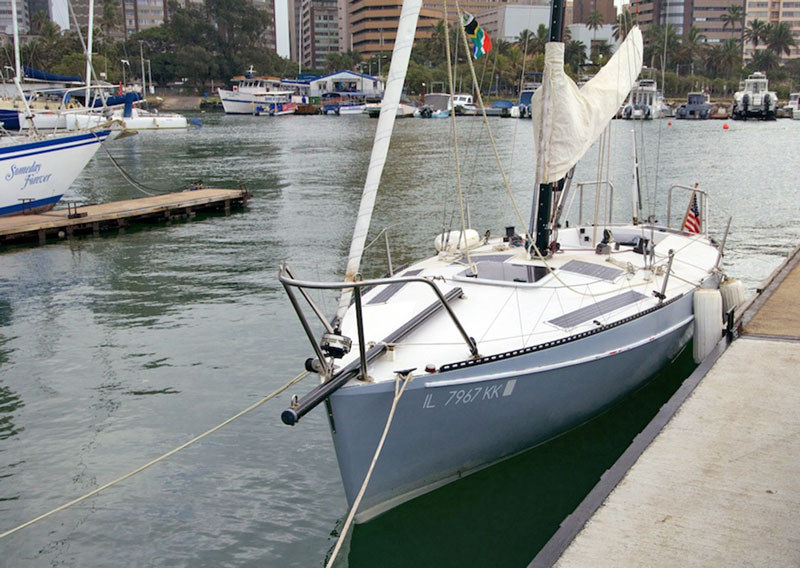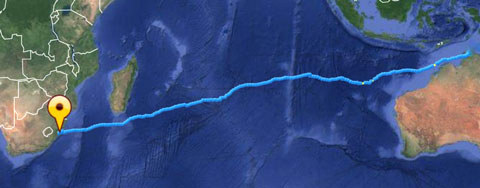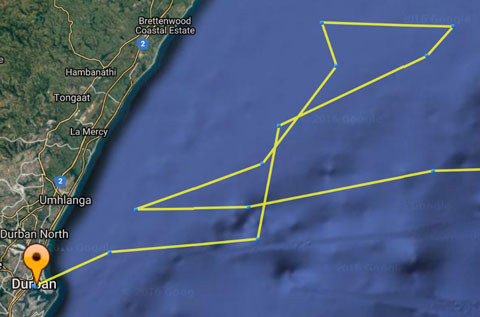
Brutal Last Miles to Africa

"Sleep, fresh water showers, and a taste or two of gin have worked wonders, though I’m not quite ready to do the passage again," solo circumnavigator Webb Chiles, a resident of Illinois, wrote to us this morning.

On July 1, Chiles, alone on his Moore 24 Gannet, departed Darwin, Northern Australia, for Durban, South Africa, a voyage that crosses 100° of longitude. Once this epic journey was complete, he filed the following hair-raising report:
"At 5 a.m., Monday, August 22, our 53rd day at sea since leaving Darwin, the wind died, and Gannet was becalmed ten miles from Durban Harbor. Confident that the 6,000-mile passage would be over in a few hours, I took advantage of the smooth conditions to fit the outboard bracket and electric Torqeedo onto the stern. The Torqeedo had not been used in months, not since I powered the last half mile to the marina in Bundaberg, Australia. I was pleased when it started at the first push of a button. Then I removed what is called the tiller arm and tilted the Torqeedo from the water. It has a limited range, and I would use it only after entering the port.
"A few minutes later the wind, which had been light and behind us, returned with a rush, but from directly ahead. I raised a triple-reefed main and partially unfurled the jib.
"The wind continued to build and build. Had I not so wanted to get in, I would have stopped sailing by 6 a.m. But I did and kept on. Gannet was heeled 40°, thrashing through and under water, lee rail buried. Activity below was impossible. One of the rules on Gannet is the same as in boxing: Protect yourself at all times. Trying to heat water for coffee, momentarily I didn’t and was thrown across the cabin. This, of course isn’t far, but I lost a good piece of skin and got a good sized lump on my elbow. I drank the coffee with air temperature water and ate a protein bar for breakfast.
"With the wind coming partially over the point of land to the south, I thought it possible the sea would be smoother closer to the coast. I was wrong. The wind there was as strong and the waves steeper. I threaded my way through a half dozen ships anchored awaiting entrance to the harbor until I ran out of room and a mile offshore tried to come about. Despite moving at speed, Gannet didn’t have the weight to do it. The wind stopped and shook her like a dog a bone. I had to do what I didn’t want to and jibe. The power of the boom going over was immense. Gannet went to almost to 90°, but Moore 24s are self-correcting boats. As I eased the sheet, she came up. Some. As I steered back past the anchored ships one of them gave a blast on her horn that I decided to interpret as applause. To the south I could see the breakwaters at Durban seven miles away.
"Wave after wave swept over Gannet and me. While being flailed in the failed attempt to tack, the jib sheets had tied themselves in a Gordian knot. Once clear of the ships, I tied down the tiller and lowered and subdued the mainsail and went forward to untangle the jib sheets so I could furl it. All brutal and dangerous.
"Finally, under bare pole and being pushed north, I called on the handheld VHF to the anchored ships, asking for wind speed and forecast. One of them answered, giving windspeed of 45 knots, forecast to go to 50 with 20-ft waves, easing in 24 hours. Gannet’s cabin was as wet as it has ever been, but she felt safer and much less likely to be rolled. She had taken a beating. We both had. I don’t think the waves ever reached 20-ft, perhaps 12- to 14-ft, but I have always preferred to err on the low side rather than high. Whatever their height, they were steep walls of seething water and big enough.
"After an unrelenting afternoon and night, the wind began to drop at 10 a.m. Tuesday almost as quickly as it rose. Even after all these years, I am sometimes amazed by how quickly waves decrease with the wind. By 1 p.m. Gannet was headed back toward Durban, now forty miles distant, making 3-4 knots under full sail across a mildly undulating sea on a sunny afternoon. Two whales spouted a few whale-lengths away. Albatrosses glided above us. We entered the harbor late the next morning and tied to the International Jetty at noon."

"Gannet has covered more than 9,000 miles since we sailed from Opua, New Zealand, less than four months ago," says Chiles. "Despite being driven and tossed on the deep blue sea, I can’t see that she has suffered any structural damage. We have done what we planned to do this year. We are both going to rest." For more on Webb Chiles’ sixth circumnavigation, see www.inthepresentsea.com.
.jpg)
